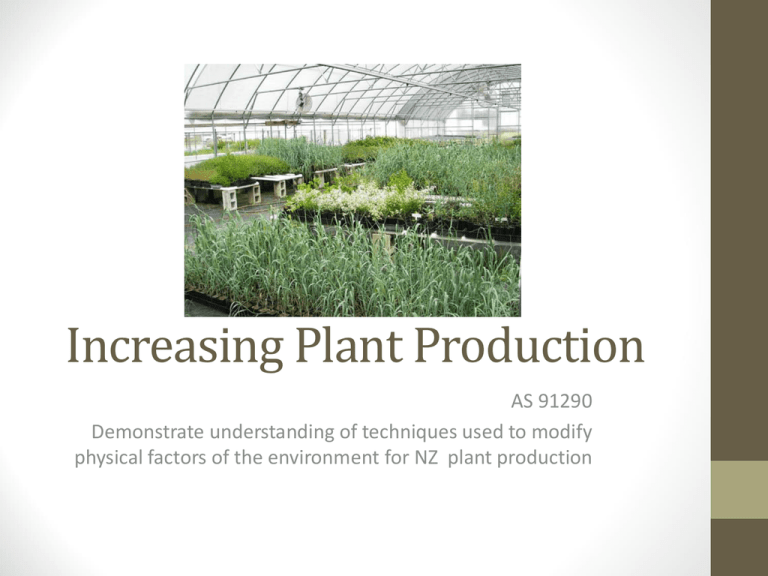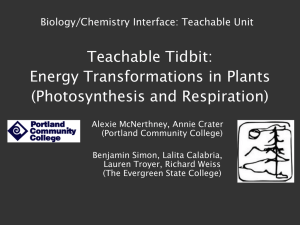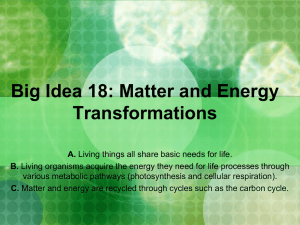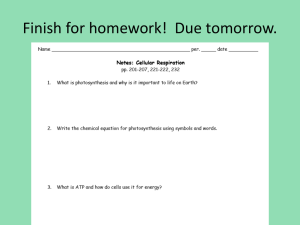
Increasing Plant Production
AS 91290
Demonstrate understanding of techniques used to modify
physical factors of the environment for NZ plant production
Contents
• THE BASICS
• Photosynthesis, respiration, transpiration, nutrient uptake, water
uptake.
• Liebig’s Law of the Minimum
• PLANT GROWTH
• Bud formation, flowering, pollination, fertilisation, fruit set,
germination, maturation, ripening.
• ENVIRONMENTAL FACTORS
• light, sunlight hours, temperature (Growing Degree Days (GDDs) or
heat units (HUs)), frost, chill requirements (as expressed by chill
units), rainfall, humidity, wind, soil type, topography.
• TECHNIQUES (see PPT number 2)
• CO2 enrichment, artificial shelter, sprinkler irrigation, tile
drainage, hail cannon, wind machines, reflective mulch,
training systems.
Plant Processes
There are 6 key processes that happen inside a plant
•
•
•
•
•
•
Converting light energy to chemical energy
Photosynthesis
Respiration
Using chemical energy to grow and function
Transpiration
Getting water from the roots to the leaves
Nutrient Uptake
Getting macro and micro nutrients into the plant
Water Uptake
Getting water from the growing media into the roots
Fertilisation/pollination Plants having sex to produce viable seeds and fruit
Learn how to spell these!
Photosynthesis
Water + Carbon Dioxide Glucose + Oxygen
H 2O +
CO2
C6H12O6 + O2
Converted to
Carbohydrates
(eg starch)
Photosynthesis
• Photosynthesis (echalk)
Photosynthesis
Is a chemical reaction occurring in the chloroplasts
found inside plant cells
• One purpose of the photosynthesis is to convert light
energy to chemical energy to be used by the plant.
• The other purpose is to create the molecule glucose
that can then be used to build cell components
Capturing Energy
• The chemical energy is initially in glucose but the plant
converts some of the glucose into starch for long term
storage.
• The energy is released in respiration to ‘power’ other cell
processes such as the formation of proteins and lipids.
Photosynthesis - Chlorophyll
• Chlorophyll is a green pigment inside the chloroplasts found in
plant cells.
• Chlorophyll is essential for photosynthesis
• What are the essential nutrients needed for chorophyll?
You do not need to
learn the structure of
chlorophyll
Photosynthesis – light absorption
So why are
plants green?
Chlorophyll does not
absorb green light –
instead it reflects
green light and it
bounces back off the
plant into your eye
and the plant (leaf)
looks green.
So what colour
light should
plants be
exposed to?
Respiration
Oxygen + Glucose Water + Carbon Dioxide
O2 + C6H12O6 H2O +
CO2
Energy released
This energy is the useful output of
respiration
The energy is released in
respiration to ‘power’ other cell
processes such as the formation of
proteins and lipids
Respiration
• The purpose of respiration is to release the energy from
glucose.
• The water and carbon dioxide are waste products and most of
the water and carbon dioxide exit the plants through the
stomata.
• Respiration occurs in all living cells in the plant. Consequently
oxygen is needed in all parts of the plants including the roots
• Summary diagram showing the
relation- ship between
photosynthesis and respiration
Transpiration
• Transpiration is the process of water
movement into the roots. Up the
stem and out of the stomata in the
leaves.
Transpiration
• Plant transpiration is pretty much an invisible process—since
the water is evaporating from the leaf surfaces, you don't just
go out and see the leaves "sweating". Just because you can't
see the water doesn't mean it is not being put into the air,
though. During a growing season, a leaf will transpire many
times more water than its own weight. A hectare of corn gives
off about 30,000-45,000 liters of water each day, and a large
oak tree can transpire 151,000 liters per year.
Respiration
• Glucose + Oxygen Carbon Dioxide + Water
Carbon dioxide (CO2) is an essential
component of photosynthesis (also called
carbon assimilation). Photosynthesis is a
chemical process that uses light energy to
convert CO2 and water into sugars in green
plants. These sugars are then used for growth
within the plant, through respiration. The
difference between the rate of photosynthesis
and the rate of respiration is the basis for drymatter accumulation (growth) in the plant.
Dry matter accumulation
• Carbon dioxide (CO2) is an essential component of
photosynthesis (also called carbon assimilation).
Photosynthesis is a chemical process that uses light energy to
convert CO2 and water into sugars in green plants. These
sugars are then used for growth within the plant, through
respiration. The difference between the rate of photosynthesis
and the rate of respiration is the basis for dry-matter
accumulation (growth) in the plant.
Nutrient Uptake
• Nutrients are up taken via the roots of the plant.
• What is the
optimum soil
pH range?
• The plant, through
photosynthesis, fixes
carbon dioxide and
water in the form of
sugars. The sugars are
used in respiration to
provide energy breaking down again to
carbon dioxide and
water. Some sugars are
synthesize into amino
acids and finally
proteins, the building
blocks of living tissue.
Liebig’s Law of the minimum
• States that growth is controlled not by the
total of resources available, but by the
scarcest resource (limiting factor).
• This concept was originally applied to
plant or crop growth, where it was found
that increasing the amount of plentiful
nutrients did not increase plant growth.
Only by increasing the amount of the
limiting nutrient (the one most scarce in
relation to "need") was the growth of a
plant or crop improved.
Liebig’s Law of the minimum - explained
The water level in the barrel represents
plant growth.
By adding more light, Phosphorus,
warmth etc there will be no further
increase in growth.
What is the limiting factor?
Nitrogen
Effect of Light and Water on Plant
Production
Click here for explanation
Kiwifruit Data Exercise
Canopy
lighter
denser
Kiwifruit Data
Crop Load
Fruit / m2
low crop load
26
high crop load
36
low crop load
35
high crop load
48
Fruit weight (g)
113
107
91
84
Overall, canopy density had a greater effect on fruit weight than crop load.
Exercise 1
Exercise 2
Exercise 3
Exercise 4
Graph the above data to show the relationship between
canopy density and crop loading
Explain the effect of canopy density on fruit size.
Explain the effect of crop load on fruit size.
Justify the manipulation in terms of quantity and quality of
kiwifruit.
Inside a leaf
Stomata
Site Establishment
Pests and Diseases
• Pests and diseases can influence the crop that can be
grown in a certain region, ie apples aren’t grown in
the Waikato and grapes are no longer commercially
grown in West Auckland due to dampness of the
climates (botrytis).
• New growth of all plants are very susceptible to pests
and diseases.
• Pests chew the tender tasty tips of plants restricting
the development of the plants and their ability to carry
out plant processes.
• Fungi such as mildew destroy apical buds.
• Pests chew the plants providing an entry point for
diseases which restricts the ability of the plant to grow
at an optimum rate.
Aphids sucking the
growing
shoot of a rose
Aphids sucking sap from
cabbages
Mildew on growing tip
Grass grubs under turf
Clean
Infected
Plate
Plates
1. Carbon
6b. Liquid
dioxide
CO2generator.
tanks.
• CO2 Enrichment
Liquid Carbon dioxide tank
supplying a greenhouse.
Carbon dioxide generator for a large
greenhouse (burns fossil fuels to generate
CO2
CO2 Enrichment
• Normal CO2 level in outside air is about 340
ppm (0.3%). All plants grow well at this level
but as CO2 levels are raised by 1,000 ppm
photosynthesis increases proportionately
resulting in more sugars and carbohydrates
available for plant growth.
• Any actively growing crop in a tightly clad
greenhouse with little or no ventilation can
readily reduce the CO2 level during the day to
as low as 200 ppm. The decrease in
photosynthesis when CO2 level drops from
340 ppm to 200 ppm is similar to the increase
when the CO2 levels are raised from 340 to
about 1,300 ppm
Fruit Development
• Which of the following Horticultural products do not develop
from a flower.
•
•
•
•
•
•
•
•
Strawberries
Bannanas
Carrots
Beans
Peas
Pumpkin
Corgetts
Tomatos
Fruit Development
• 5 stages of fruit development
•
•
•
•
•
Bud set
Bud burst
Pollination/ fertilisation
Fruit development
Fruit ripening
Link the five stages of fruit development with an image
1.
2.
3.
4.
5.
Bud set
Bud burst
Pollination/ fertilisation
Fruit development
Fruit ripening
Then give each a definition
Step
Bud set
Bud burst
Pollination/
fertilisation
Fruit development
Fruit ripening
Environmental factors affecting step
The bud develops at the node. On some plants this
occurs on new growth and on some it occurs on old
growth. Most fruit trees require this bud tissue to
undergo a cold period before it will burst.
The basic sturucture of the flower has developed
inside the bud and then bursts out (blossums).
Most horticultural crops are insect pollinated. The
exception is cerrals and maize.
Fertilisation is the process of the pollen grain growing
into the flower tissue
The fruit swells
Starch is converted to sugar in the fruit to make it
attaractive to animals/ birds.
Environmental factors affecting
fruit development
Step
Environmental factors affecting step
Bud set
Temperature,
Bud burst
Frost – young flower suseptable to frost damage
Wind - young flower suseptable to wind damage
Pollination/ fertilisation
Anything that reduces insect activity reduces
pollination (wind, temp, rain)
Fertilisation is the growth of the pollen tube. So temp
and availiability of sugars in the flower tissue affect
fertilisation
Fruit development
Hail, sun, temp, water availibility
Fruit ripening
Sun. temp









